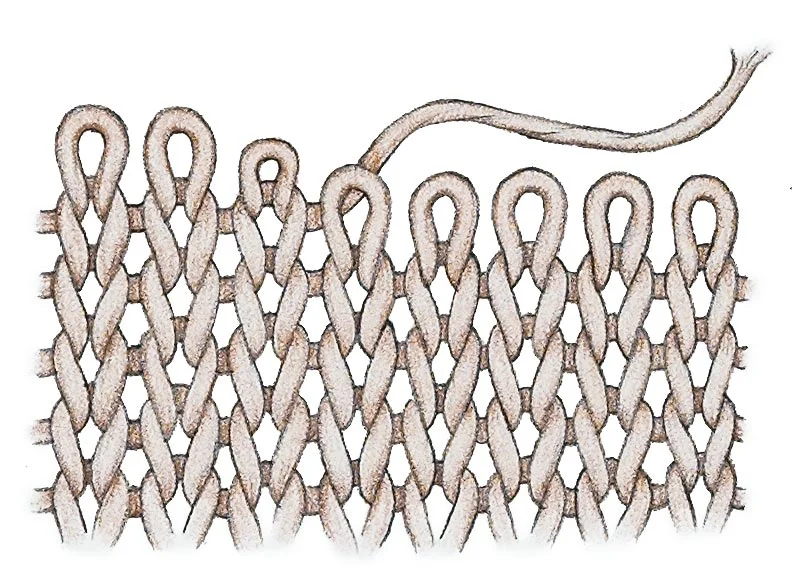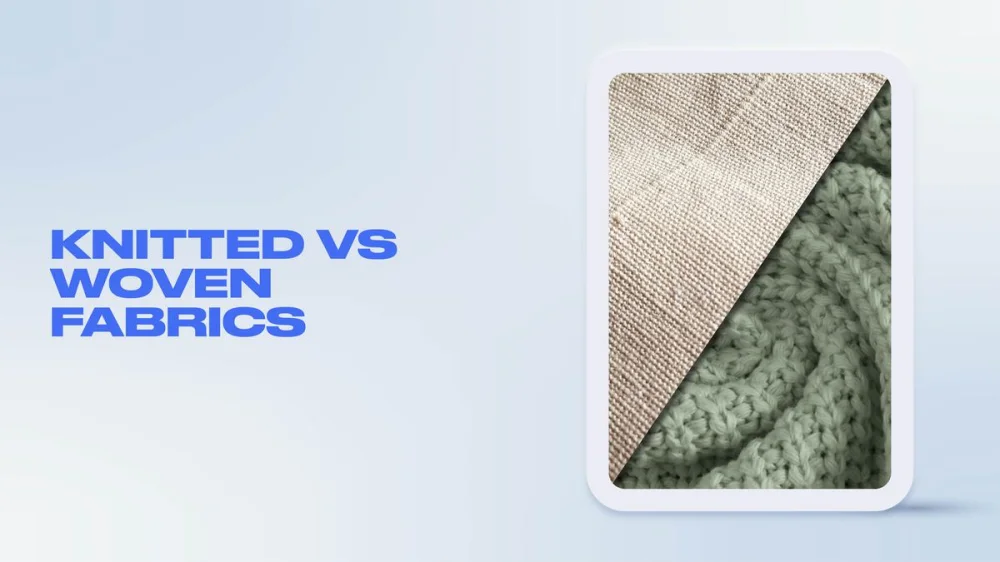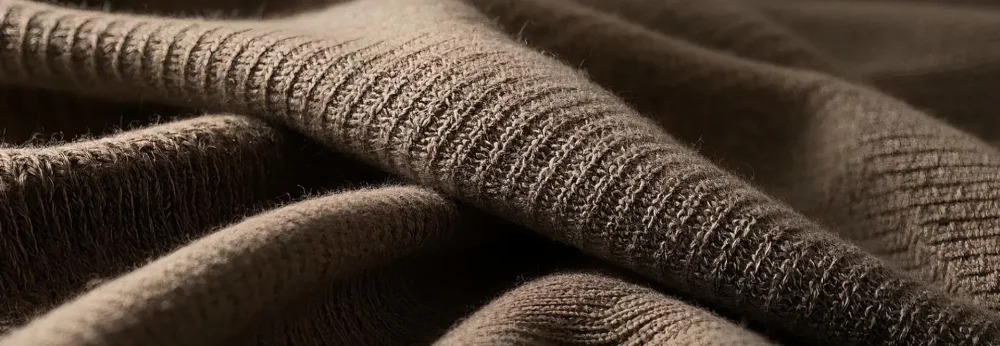If you’ve ever asked yourself, what is knit fabric, you’re not alone! Knit fabric is a textile made by interlocking loops of yarn with needles, giving it a soft, stretchy feel. You’ll find knit fabric in your favorite pajamas, T-shirts, and cozy sweaters because it moves with your body and feels comfortable all day.
You might notice knit fabric everywhere, from high-end fashion lines to everyday basics.
Its stretchy, breathable nature makes it a go-to choice for comfort seekers and style lovers alike.
Key Takeaways
Knit fabric is made by looping yarns, giving it a soft, stretchy feel that moves with your body for all-day comfort.
Its unique looped structure makes knit fabric breathable, flexible, and able to bounce back to its original shape after stretching.
Different types of knit fabrics, like jersey, rib, and interlock, offer various textures and uses, from T-shirts to cozy pajamas.
Knit fabrics are easy to care for, usually machine washable, and resist wrinkles, making them practical for everyday wear.
Choosing high-quality knit fabric, like Friendtex pajamas, ensures durability, softness, and moisture-wicking benefits for lasting comfort.
What is Knit Fabric?
If you want to know what knit fabric is, you’re in the right place. Let’s break it down together so you can spot it and understand why it feels so different from other fabrics.
Knit Fabric Structure

When you look closely at knit fabric, you’ll see tiny loops of yarn all connected. These loops are the secret behind the soft, stretchy feel you love in your favorite T-shirt or pajamas.
The basic knitting process uses needles or hooks to pull yarn through existing loops, creating new ones. This forms rows called courses (side to side) and columns called wales (up and down).
At a microscopic level, knit fabric is made up of intermeshing loops. These loops create a three-dimensional structure that’s much more flexible than what you find in woven fabrics. The way the loops are arranged can change how the fabric feels and stretches.
For example, weft knitting forms loops horizontally, while warp knitting forms them vertically. The shape and density of these loops affect how stretchy or stable the fabric is. Weft knits usually stretch more and feel softer, while warp knits offer a bit more stability.
You might notice that knit fabrics bounce back to their original shape after you stretch them. That’s because the yarn wants to return to its relaxed state, and the looped structure helps it do just that. This is why knit fabric feels so comfortable and moves with your body.
Tip: Next time you wear knit pajamas, try gently stretching the fabric. You’ll see how the loops let it move and snap back into place!
How Knit Fabric Differs from Woven?

Now, let’s talk about how knit fabric stands apart from woven fabric. If you’ve ever wondered what knit fabric is compared to woven, here’s a simple way to picture it:
Knit fabric is made by looping yarns together, while woven fabric is made by weaving threads over and under each other at right angles. This difference in construction changes everything about how the fabric feels and behaves.
Here’s a quick table to help you see the main differences:
Aspect | Knit Fabric | Woven Fabric |
|---|---|---|
Structure | Made by interlooping yarns (loops) | Made by interlacing threads at right angles (warp and weft) |
Stretch | High stretch and flexibility | Low stretch, more rigid |
Feel | Soft, drapes well, cozy | Crisp, holds shape, less flexible |
Use | Pajamas, T-shirts, sportswear | Jeans, dress shirts, jackets |
Knit fabrics have a looser structure with bigger gaps between the loops. This makes them stretchy and flexible, perfect for clothes that need to move with you. Woven fabrics, on the other hand, are tighter and more stable, which is why they’re used for things like jeans or dress shirts.
You’ll also notice that knit fabrics often have better tensile strength and bending resistance. The overlapping stitch structure gives them extra flexibility and strength, making them great for activewear and sleepwear. Woven fabrics are tougher when it comes to resisting pokes or sharp objects, but they don’t stretch much.
So, when you ask what knit fabric is, remember: it’s all about those loops! They give knit fabric its unique stretch, comfort, and softness, setting it apart from woven fabrics in both feel and function.
Knit Fabric Features

Stretch and Comfort
When you slip into a garment made from knit fabric, you notice the difference right away. The loops in knit fabrics allow them to stretch in multiple directions. This stretchiness means your clothes move with you, not against you. You can bend, twist, or lounge without feeling restricted.
That’s why knit fabric is so popular for T-shirts, leggings, and pajamas. The fabric hugs your body gently, giving you a snug but comfortable fit. Many people love how knit fabrics feel soft and cozy, even after hours of wear.
If you follow knitwear trends, you’ll see that designers choose knit fabric for both style and comfort. Rib knits and jersey knits are especially known for their flexibility and ability to bounce back to shape.
Breathability and Care
Knit fabric stands out for its breathability. The looped structure creates tiny gaps, letting air flow through easily. This helps keep you cool and dry, even on warm nights or during busy days. Scientific studies show that longer loops in knit fabrics increase air permeability, making them more breathable than many woven fabrics.
Moisture-wicking properties are another bonus, especially in viscose knit fabric and bamboo blends. These fabrics pull sweat away from your skin, keeping you fresh. Taking care of knit fabric is simple.
You can usually machine wash it on a gentle cycle with cold water. Air drying helps maintain the fabric’s softness and shape. Always check the care label, but most knit fabrics resist wrinkles and are easy to fold or hang.
Friendtex Knit Pajamas Example
Let’s look at Friendtex knit pajamas as a real-world example. These pajamas use high-quality knit fabric, including modal and viscose knit fabric, to deliver unmatched comfort.
You get pajamas that are ultra-soft, stretchy, and breathable. The moisture-wicking feature keeps you dry all night. Friendtex pajamas hold their shape and softness, even after many washes. They resist pilling and fading, so they look and feel new for longer.
The brand’s focus on sustainable materials and careful manufacturing means you enjoy both comfort and durability. If you want to keep up with knitwear trends, Friendtex knit pajamas offer a stylish and practical choice for every season.
Types of Knit Fabrics
You’ll find many types of knit fabrics in your closet, each with its own feel and purpose. Let’s break down the most popular ones so you can spot them and know what makes each special.
Jersey Knit Fabric
Jersey knit fabric is everywhere. You see it in T-shirts, dresses, and comfy pajamas. This fabric uses a single set of needles to create a smooth front and a slightly textured back. Jersey knit fabric stretches easily, especially if it contains elastane.
The edges curl when you pull them, which is a classic sign. You get a lightweight, breathable material that feels soft against your skin. Cotton knit fabric is often used for jersey knit fabric, making it gentle and absorbent.
You’ll notice that jersey knit fabric resists wrinkles and keeps its shape after washing. Friendtex uses premium jersey knit fabric in their pajamas, so you enjoy comfort and durability night after night.
Tip: If you want a fabric that drapes well and feels cool, jersey knit fabric is a top choice.
Rib Knit
Rib knit stands out because of its vertical ribs. You’ll see these ribs on cuffs, collars, and sweater edges. Rib knit fabric is made by alternating knit and purl stitches, which gives it a stretchy feel across the width.
The edges don’t curl, so garments stay neat. You’ll find rib knit in T-shirts, tank tops, and sweater knits. This fabric hugs your body and snaps back into shape, making it perfect for fitted clothing. Rib knit patterns like 1×1 or 2×2 change the width and texture of the ribs.
Interlock Knit
Interlock knit is a type of double knit, created by knitting two layers of jersey together. You get a fabric that looks the same on both sides, with a smooth finish and tight weave. Interlock knit is thicker and more stable than jersey knit fabric, so it’s easier to sew and less likely to curl.
You’ll find interlock in leggings, activewear, and children’s clothes. Cotton knit fabric is a popular choice for interlock because it adds softness and warmth. Friendtex uses interlock knit for pajamas that need extra durability and a cozy feel.
Other Knit Fabrics
You’ll discover even more types of knit fabrics as you explore. Sweater knits are thicker and warmer, perfect for pullovers and cardigans. Viscose knit fabric offers a silky texture and great drape, ideal for stylish tops and dresses.
Novelty knits, like pointelle or jacquard, add visual interest with patterns and textures. French terry and fleece are soft and absorbent, making them favorites for casual wear and loungewear. Friendtex selects premium viscose knit fabric and sweater knits to create pajamas that combine comfort, breathability, and style.
Here’s a quick table to help you compare:
Knit Fabric Type | Key Features | Common Uses |
|---|---|---|
Jersey knit fabric | Lightweight, stretchy, breathable | T-shirts, pajamas, dresses |
Rib knit | Vertical ribs, stretchy, stable | Cuffs, collars, sweaters |
Interlock knit | Thick, reversible, stable | Leggings, activewear |
Sweater knits | Warm, textured, cozy | Pullovers, cardigans |
Viscose knit fabric | Silky, drapes well, breathable | Tops, dresses, pajamas |
Novelty knits | Unique patterns, visual interest | Fashion garments |
You can see how Friendtex uses these types of knit fabrics to create high-quality, comfortable pajamas and sleepwear for every style and season.
Pros and Cons of Knit Fabrics
When you look at the pros and cons of knit fabrics, you’ll see why so many people love them for everyday wear and sewing projects. Let’s break down what makes knit fabrics a favorite—and what you should keep in mind.
Advantages
Knit fabrics bring a lot to the table. Here’s what you can expect:
Exceptional comfort and stretch. Knit fabrics move with your body, giving you freedom whether you’re relaxing or on the go.
Softness and breathability. The looped structure lets air flow, keeping you cool and comfortable all day.
Shape retention. Many knits, like rib knit, hug your body and bounce back after stretching, so your clothes keep their fit.
Durability. Rib knits last longer than many standard fabrics, and Friendtex knit pajamas hold up wash after wash without losing softness or shape.
Easy care. Most knit fabrics resist wrinkles and are simple to wash. Friendtex knit pajamas, for example, are machine washable and maintain their quality with minimal effort.
Moisture-wicking. Many knits pull sweat away from your skin, helping you stay fresh.
Versatility. You can wear knits for lounging, working out, or dressing up.
Sustainability. More brands now use eco-friendly fibers, making knits a smart choice for the planet.
Tip: If you want clothes that feel good and last, look for high-quality knit fabrics like those used in Friendtex pajamas.
Considerations
While knit fabrics offer many benefits, you should know a few things before starting your next project. Here are some tips for sewing with knit fabric:
Choose the right knit for your design. Heavier knits give structure, while lighter ones drape softly.
Always pre-wash your fabric to avoid shrinkage later.
Use ballpoint or stretch needles to prevent snags.
Handle edges carefully—knits can curl or stretch out of shape.
Pay attention to the stretch direction when cutting your pieces.
Gentle washing and low-heat drying help maintain elasticity and reduce pilling.
Knit fabrics may pill or snag if not cared for properly. They need a bit more attention than woven fabrics, but with the right approach, you’ll enjoy their comfort and style for a long time. If you’re new to sewing, following these tips for sewing with knit fabric will help you get great results.
Conclusion
You’ve learned that knit fabric stands out for its stretch, comfort, and easy care. The looped structure makes knit fabric perfect for everything from T-shirts to pajamas. You can find knit fabric in many styles, each offering softness and flexibility.
If you’re new to sewing, don’t let myths hold you back—knit fabric is beginner-friendly and versatile. For high-quality options, Friendtex offers trusted knit fabric products that combine comfort, durability, and style. Try knit fabric in your next project and enjoy the difference it brings to your wardrobe!
Knit fabric stretches and recovers, making it ideal for activewear and loungewear.
Friendtex provides sustainable, certified knit fabric for brands and individuals.
Ready to explore? Knit fabric opens up endless possibilities for comfort and creativity!
FAQ
What makes knit fabric different from woven fabric?
You’ll notice knit fabric stretches and feels soft because of its looped structure. Woven fabric feels stiffer and does not stretch much. Knit fabric works great for comfy clothes like pajamas and T-shirts.
Can I machine-wash knit fabric?
Yes, you can! Most knit fabrics handle gentle machine washing well. Use cold water and a mild detergent. Air drying helps keep the fabric soft and stretchy.
Why do my knit clothes sometimes pill?
Pilling happens when fibers rub together and form tiny balls. You can reduce pilling by washing your knit clothes inside out and using a gentle cycle. High-quality knits, like those from Friendtex, resist pilling better.
Is knit fabric good for sensitive skin?
Absolutely! Knit fabrics, especially those made from cotton or bamboo, feel soft and gentle. They rarely irritate your skin. If you have sensitive skin, look for pajamas made with natural knit fibers.
What are some common uses for knit fabric?
You’ll find knit fabric in:
Pajamas
T-shirts
Leggings
Sweaters
Baby clothes
Knit fabric works well for anything that needs comfort and stretch.


